Welcome!
We’re glad you want to learn more about our research project.
Modeling news flows: How feedback loops influence citizens beliefs and shape democracy

Welcome!
We’re glad you want to learn more about our research project.
As the end of NEWSFLOWS gets closer, it is time to discuss results, methodological advancements, and next steps. In the second week of september, we therefore hosted a series of informal discussions and workshop sessions with colleagues from different countries. Next to focused discussions on how to best studies news flows in different settings, we also enjoyed informal chatter with present and past project members as well as interested other colleagues around the cumulating event on Friday: Damians inaugural lecture, in which of course also many topics at the center of the NEWSFLOWS project were addressed.
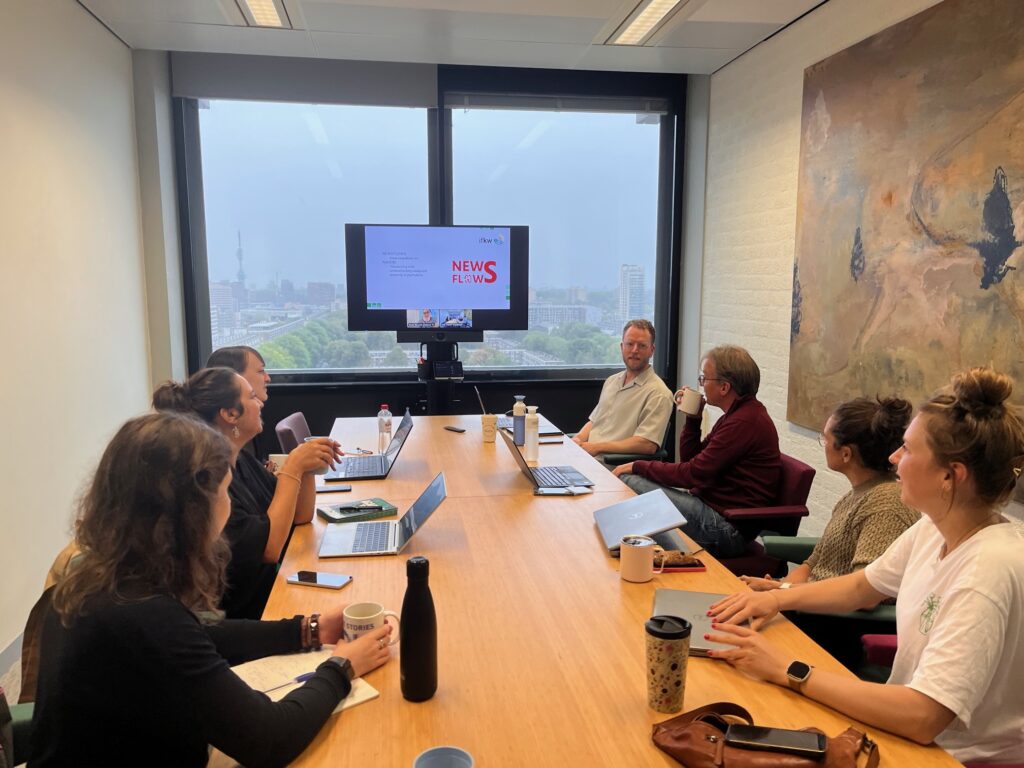
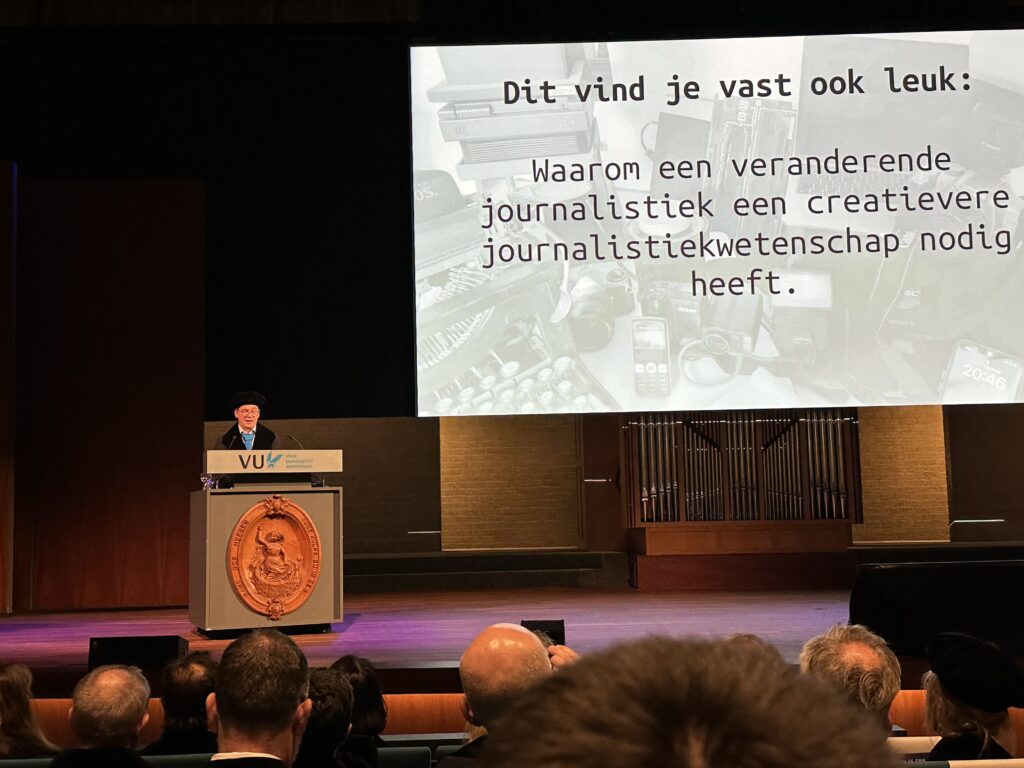
13 September was a special day for NEWSFLOWS: Mónika Simon defended her thesis “What happens on the fringes, stays on the fringes? Information flows in the contemporary media system. In her thesis, she studied how and under which circumstances information flows from the fringes of the mainstream. As the summary on the back of her thesis says:
The increasingly fragmented but at the same time interwoven nature of the contemporary information landscape poses new challenges to existing theory and methodology in understanding the information flows that shape public debate.
Through three empirical chapters, this dissertation seeks to unravel the intricate role of dark platforms in the contemporary media system. It not only sheds light on their multifaceted impact but also provides methodological and theoretical insights that can advance our understanding of information flows within the ever-evolving, multilayered information ecosystem.
Congratulations, Dr. Simon! We are incredibly proud of you!
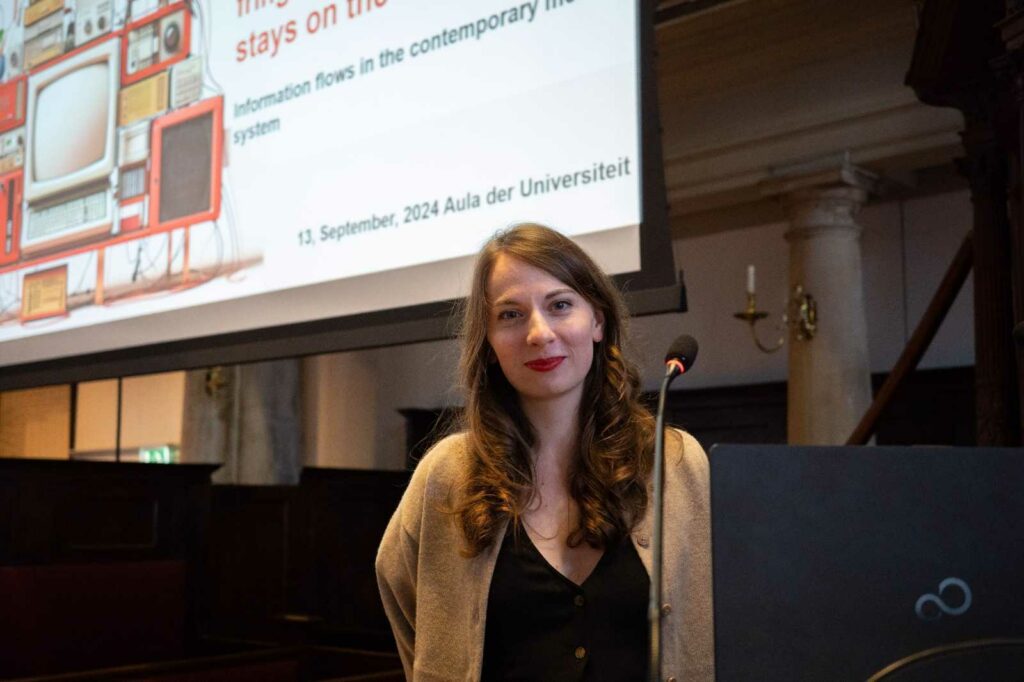
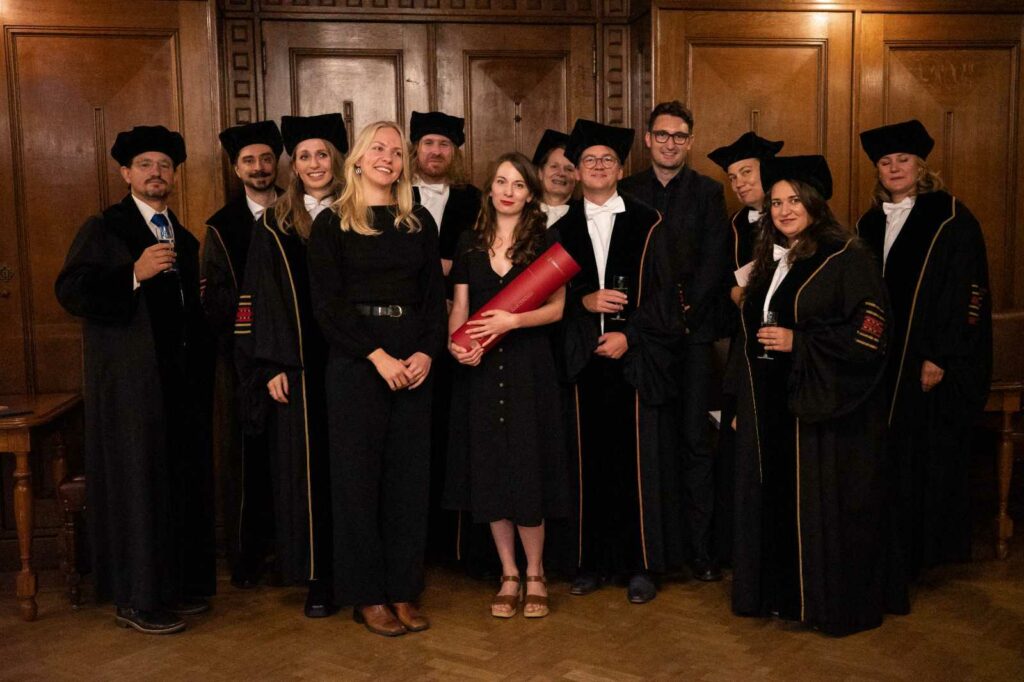

Within the NEWFLOWS project, we develop methodological approaches to study news flows. As the project progresses, it’s time to share insights with others in form of workshops and lectures. In June, we organized such training workshops together with the COMPTEXT conference in Amsterdam and a COST Action “OPINION” training school in Salamanca. Amongst other activities, Johannes Gruber was teaching how to use locally run large-language models for analysing news events.
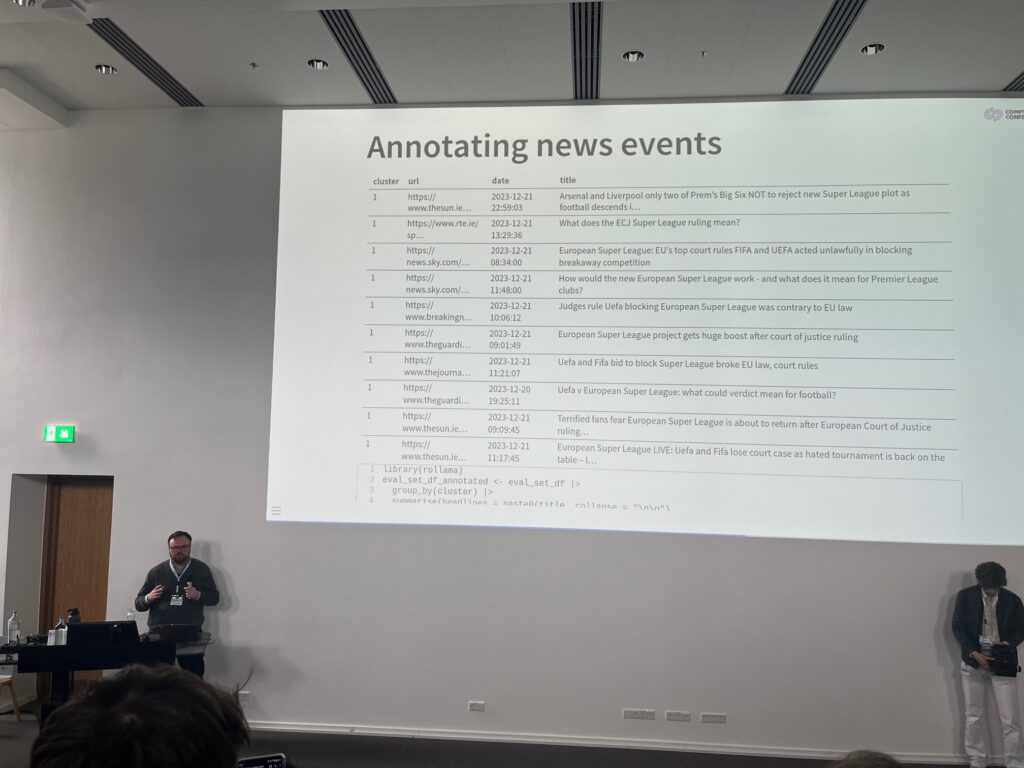
But we also use other channels to reach out. For instance, the podcast “What is it about computational communication science?” devoted a whole eposode (LINK) to Mónika Simon’s work on information flows in Telegram:
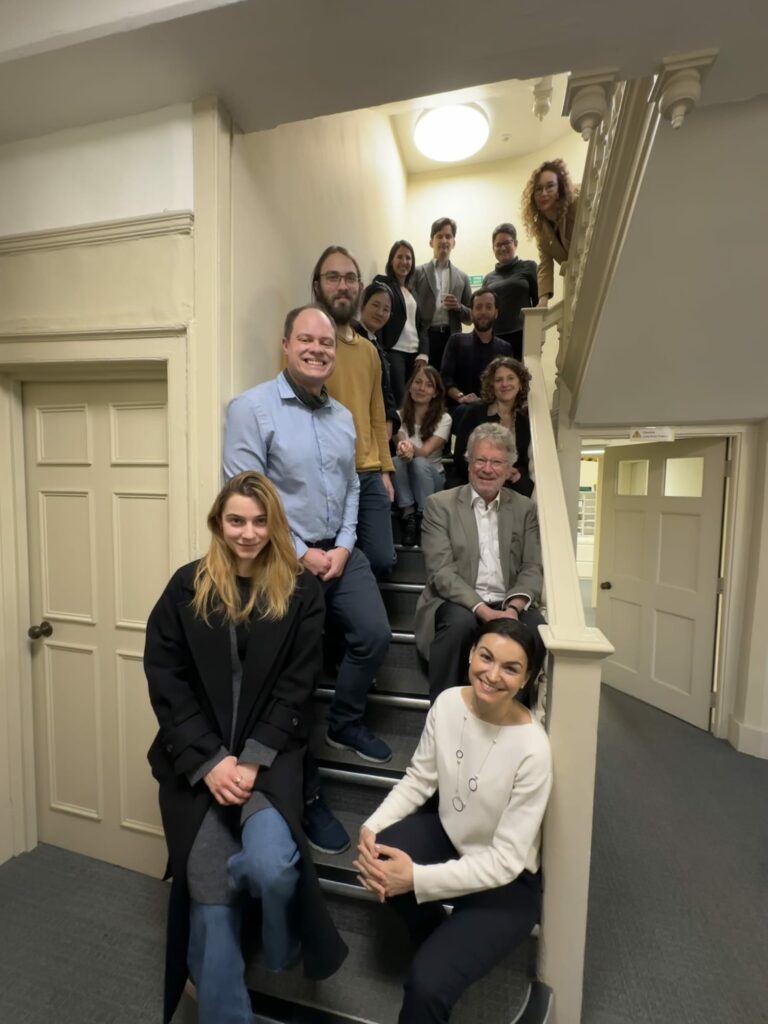
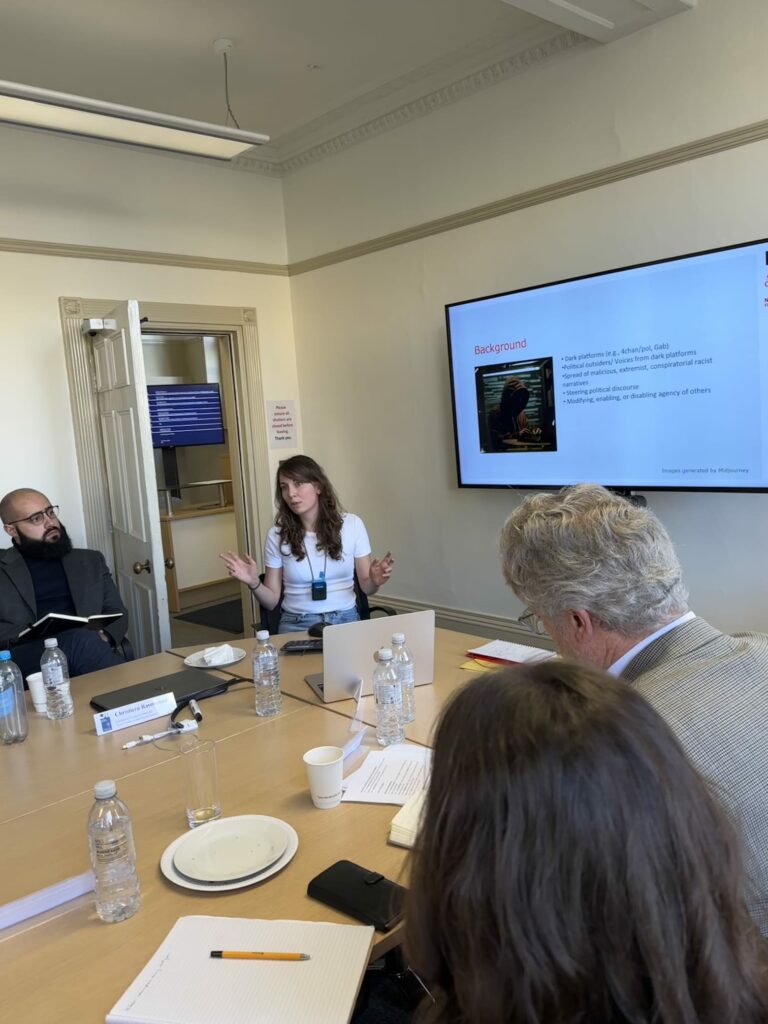
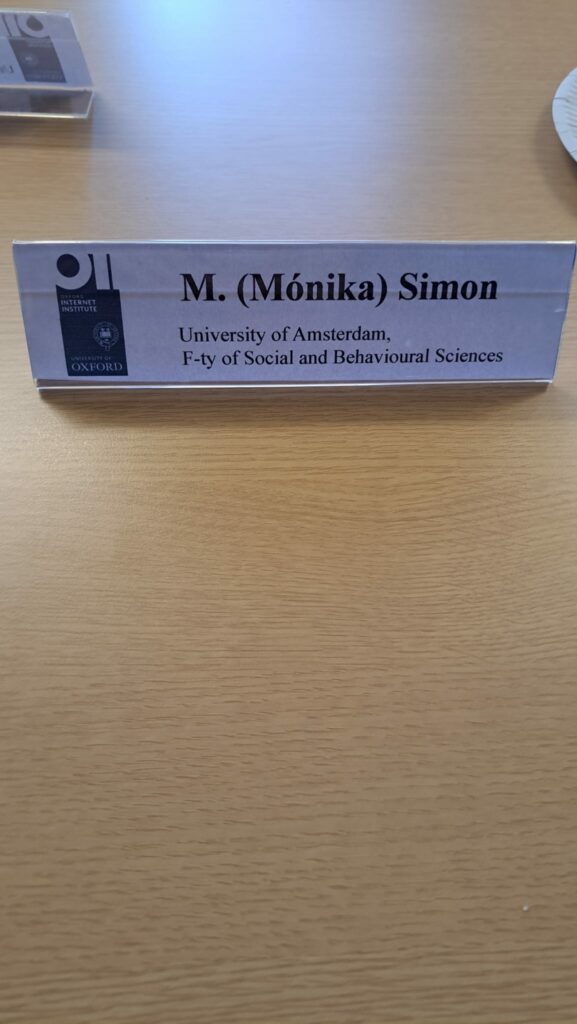
On January 26, Mónika, participated as a speaker at the Oxford Research forum on ” The Implications of the Russian War in Ukraine for Global Information, Communication, and Cybersecurity“, which was organised and hosted by the Oxford Internet Institute (OII) and The Portulans Institute. During this research forum a diverse group of 16 early career scholars, representing 8 countries and 12 universities have presented their research on various facets of the Russian invasion of Ukraine.
The participants have presented valuable insights on a number of important topics surrounding Russia’s war in Ukraine including Propaganda, Narratives, and Diplomacy, Public Reception and Resistance, Innovative Approaches to Cybersecurity and Surveillance, Shaping Social Networking, and Regulating Propaganda, Security, and Information.
Mónika’s presentation was dedicated to her study on cross-platform discursive information flows surrounding the early stages of the Russian invasion of Ukraine which she coauthored with Savvas Zannettou, and Anne, Kasper and Damian. In this study we employed a combination of state-of-the-art computational methods on multi-platform data to assess the influence of dark platforms in the contemporary media system in the context of discourse surrounding the Russian invasion of Ukraine. In a nutshell, findings of this study indicated that the influence of dark platforms is negligible compared to legacy media, and mainstream social media. Moreover, the most influential topics that managed to transcend the boundaries of the dark platform agenda and influence the rest of the studied agendas did not appear harmful at a glance. Upon closer examination, however, we detected a substantial harmful language rate in the texts that made up the most influential topics on the dark platform agenda. Notably, these posts exhibited a significantly higher levels of toxicity-related language compared to texts on other studied agendas. A preprint of this study is available via https://osf.io/qamf7 and will be featured in Mónika’s Dissertation.
We are grateful for the invitation to attend this forum and we look forward to continuing the conversation with the OII and the many talented young scholars who attended this important event. Special thanks to Elizaveta (Lisa) Chernenko (OII) who spearheaded the organisation of the research forum.
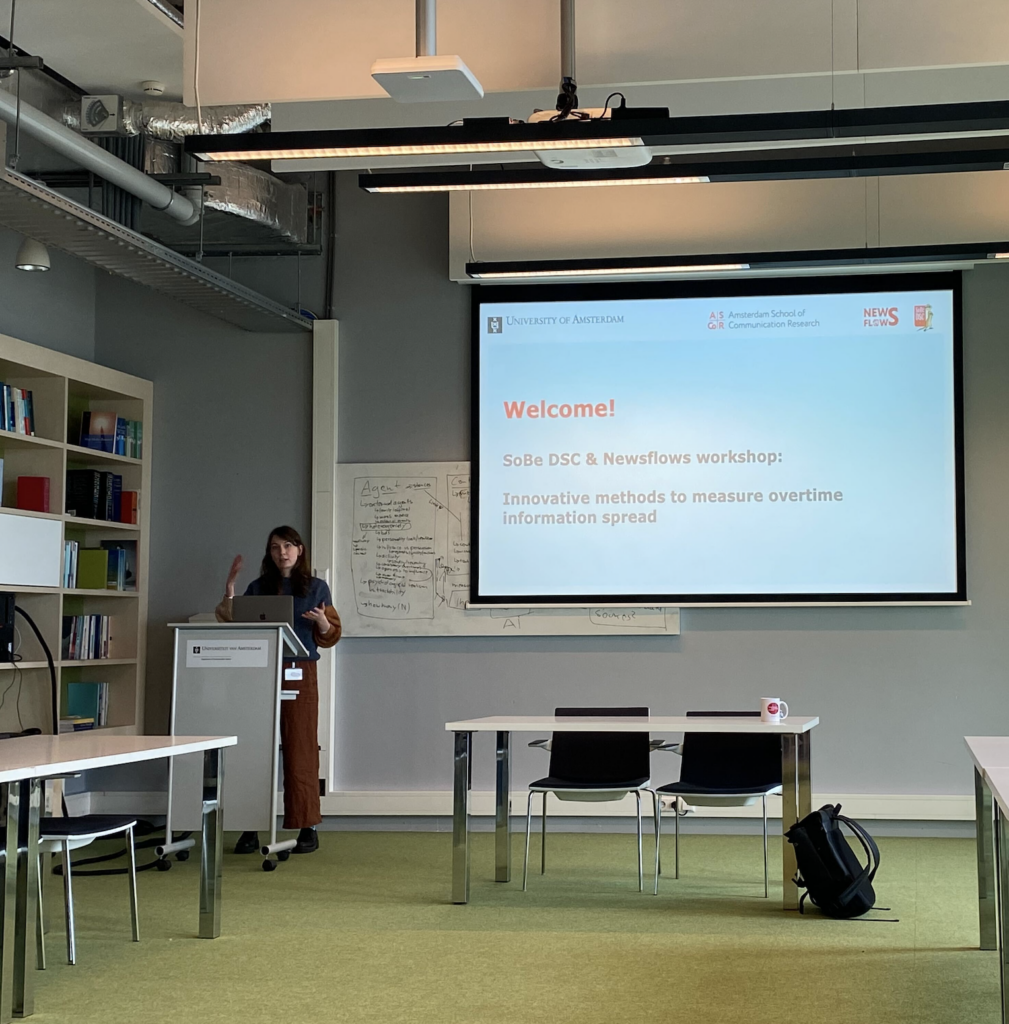
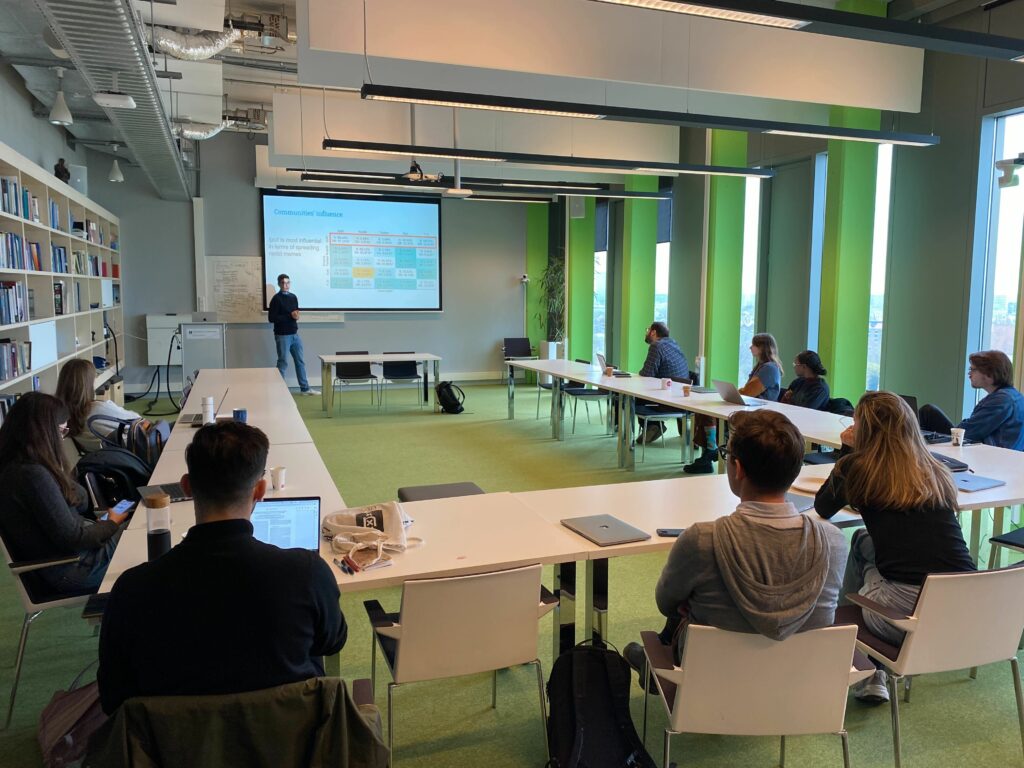
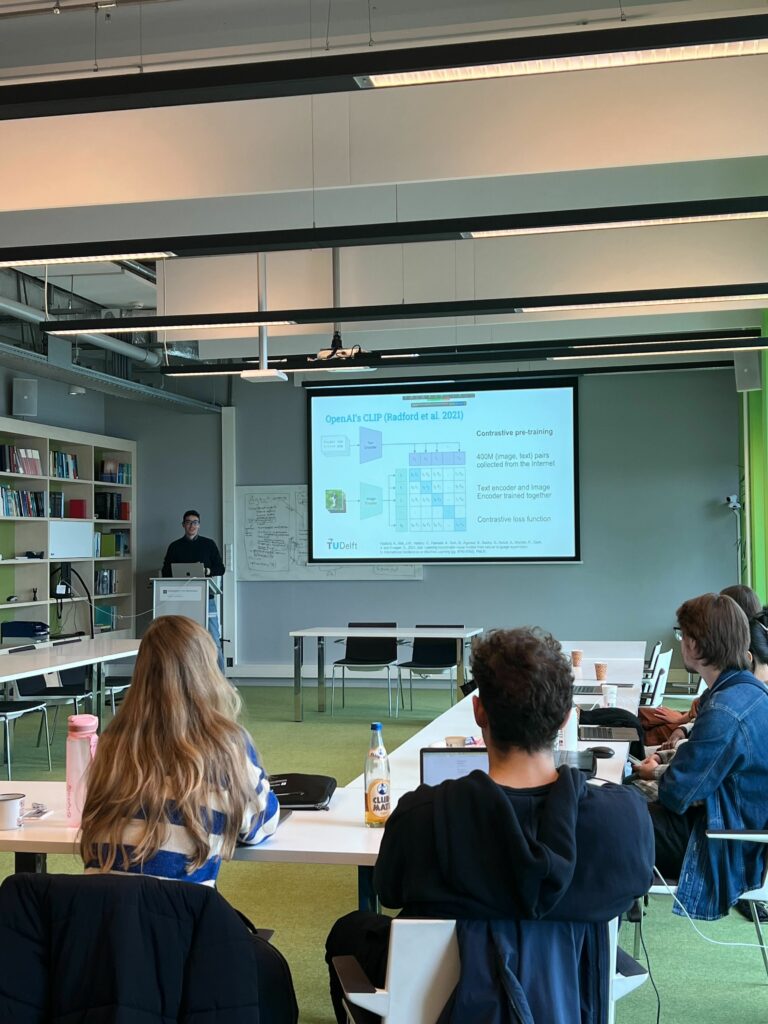
On April 21, the Newsflows team organized a full day workshop on innovative methods to trace information flows. In this workshop, Dr. Savvas Zannettou (TU Delft, Max Planck Institute for Informatics, International Data-driven Research for Advanced Modeling and Analysis Lab) presented two innovative methods: (1) Hawkes processes to model complex influence dynamics, (2) Analyzing multimodal data using contrastive learning. The event took place in Roeterseiland Campus, and was hosted by the Newsflows project & funded by the Social and Behavioural Data Science Centre.
The workshop aimed to bring together scholars from different disciplines to foster collaboration and synergies in tracing information flows across platforms, actors, and entities. Participants sought to learn about novel methods and share their own approaches and experiences to address common challenges.
During the first part of the workshop, Dr. Zannettou discussed the application of Hawkes processes to study the spread of news, memes, and hate speech across web communities. Hawkes processes are stochastic processes that model the arrival times of events, allowing researchers to identify patterns of influence within a web community. This information can be used to detect influential users and communities and predict future events, providing insights into social behavior and enabling targeted interventions. In addition, Mónika, our team member, briefly presented her recent study, which is a collaboration with Dr. Zannettou, showcasing the application of Hawkes processes to trace topic-based information flows across various platforms such as 4chan, Reddit, Twitter, and newspapers.
In the second part, Dr. Zannettou focused on analyzing multimodal data using contrastive learning. This approach employs AI models to assess content similarity across text and images, enabling the extraction of semantic relationships regardless of modality. These methods contribute to a more comprehensive understanding of online information spread and patterns of influence, regardless of the type of content.
Overall, the workshop was a great success. We had excellent discussions while learning about each others research projects and methods. We are looking forward to continuing this interdisciplinary dialogue between social scientists and computer scientists in the future.
With a one-year corona-delay, we were this year able to participate in Lowlands Science. As one of the biggest and most popular music festivals in the Netherlands, the 60,000 tickets were sold out within minutes. At that festival, the NEWSFLOWS team had a stand in which visitors could explore their own data and get an idea in how far it represents a bubble – or not. If they chose so, they could donate data to us – and many more than we expected did so, we even had to print more forms in between! But above all, we also had many meaningful discussions with literally hundreds of people!


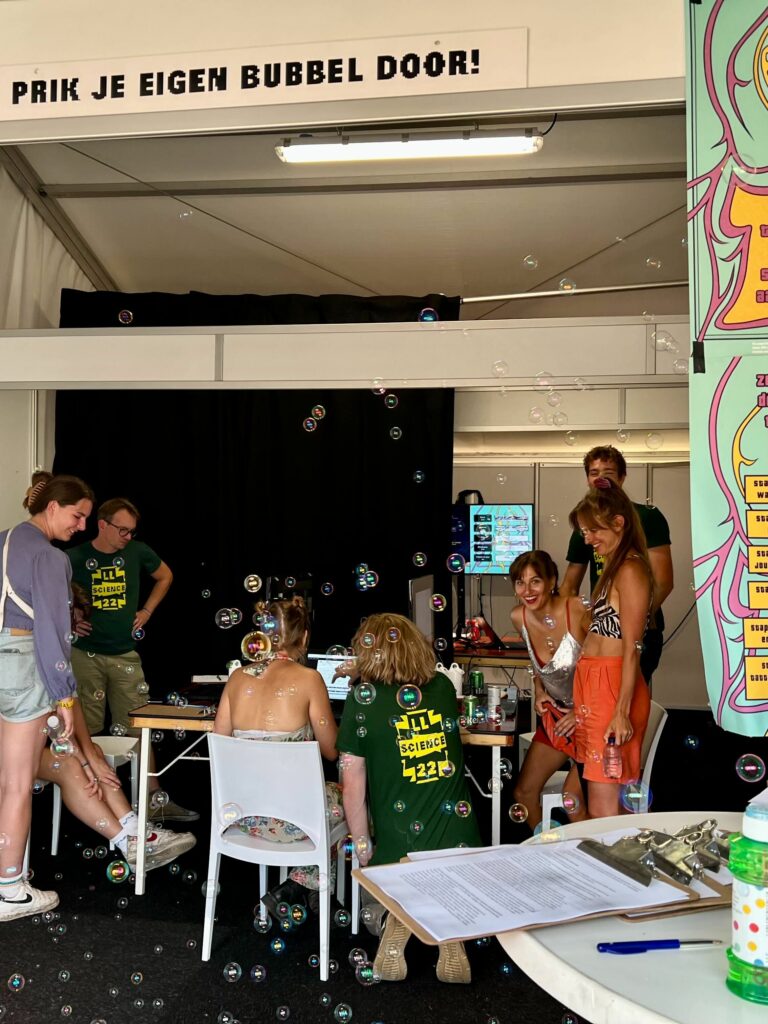


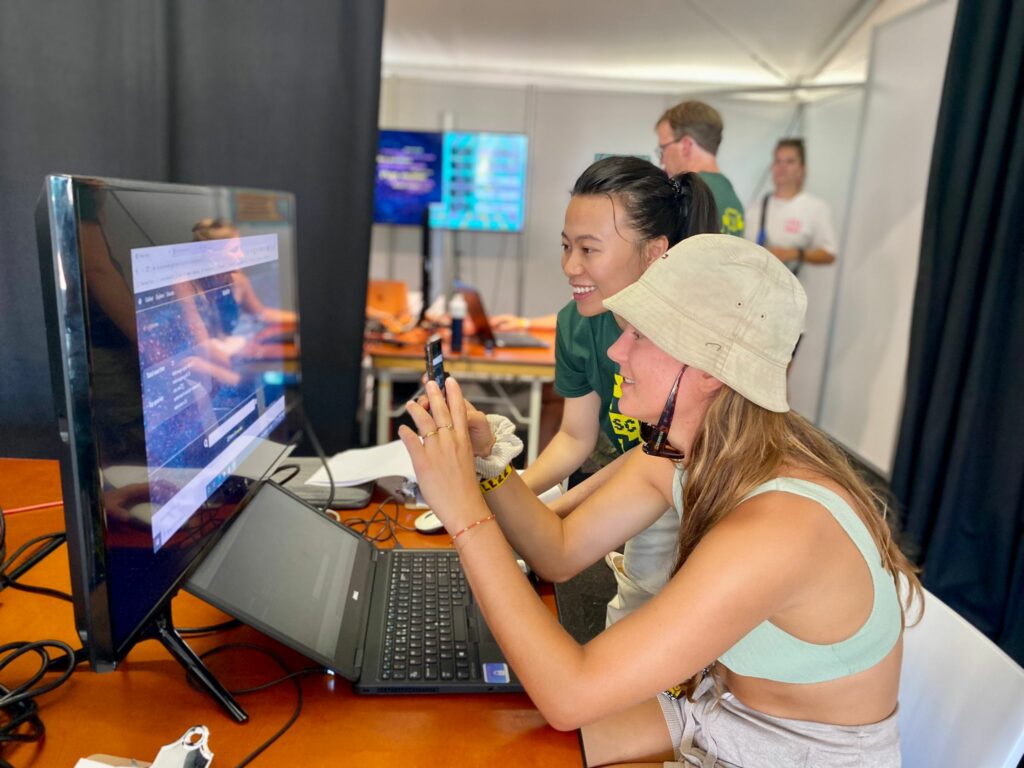
Reaching out beyond the communication science community, NEWSFLOWS was present at the European Political Science Association (EPSA) conference in Prague. Below the slides on Damian’s work on conceptual and theoretical considerations to move beyond the metaphors of echo chambers and filter bubbles.
Last week, we hosted a two-day workshop to discuss ways to study feedback loops in news recommendation. We discussed previous experiences on field experiments as well as ways forward. In particular, we worked on the development of a platform for field experiments on human-algorithmic feedback loops in news recommender systems. Building on earlier work from our group [1] [2], we worked towards further experiments to conduct within NEWSFLOWS and to further disseminate our approach to other interested researchers.
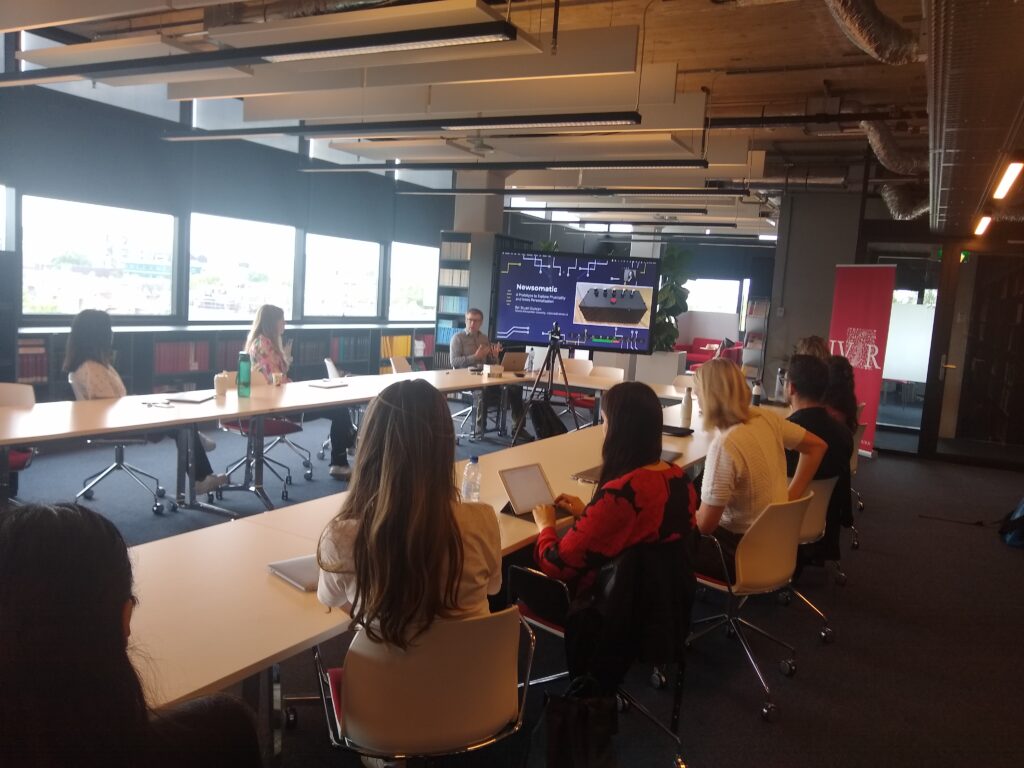
@article{Loecherbach2020,
abstract = {Abstract Today's online news environment is increasingly characterized by personalized news selections, relying on algorithmic solutions for extracting relevant articles and composing an individual's news diet. Yet, the impact of such recommendation algorithms on how we consume and perceive news is still understudied. We therefore developed one of the first software solutions to conduct studies on effects of news recommender systems in a realistic setting. The web app of our framework (called 3bij3) displays real-time news articles selected by different mechanisms. 3bij3 can be used to conduct large-scale field experiments, in which participants' use of the site can be tracked over extended periods of time. Compared to previous work, 3bij3 gives researchers control over the recommendation system under study and creates a realistic environment for the participants. It integrates web scraping, different methods to compare and classify news articles, different recommender systems, a web interface for participants, gamification elements, and a user survey to enrich the behavioural measures obtained.},
author = {Loecherbach, Felicia and Trilling, Damian},
doi = {10.5117/CCR2020.1.003.LOEC},
issn = {2665-9085},
journal = {Computational Communication Research},
number = {1},
pages = {53--79},
title = {{3bij3 ‐ Developing a framework for researching recommender systems and their effects}},
url = {https://www.ingentaconnect.com/content/10.5117/CCR2020.1.003.LOEC},
volume = {2},
pdf = {https://computationalcommunication.org/ccr/article/view/11/11},
year = {2020}
}@inproceedings{Loecherbach2021,
address = {New York, NY, USA},
author = {Loecherbach, Felicia and Welbers, Kasper and Moeller, Judith and Trilling, Damian and {Van Atteveldt}, Wouter},
booktitle = {13th ACM Web Science Conference 2021},
doi = {10.1145/3447535.3462506},
url = {https://dl.acm.org/doi/pdf/10.1145/3447535.3462506},
file = {:home/damian/SURFdrive/literatuur-mendeley/Loecherbach et al.{\_}2021.pdf:pdf},
isbn = {9781450383301},
keywords = {acm reference format,damian trilling,diversity,felicia loecherbach,judith moeller,kasper welbers,news recommender systems},
month = {jun},
pages = {282--290},
publisher = {ACM},
title = {{Is this a click towards diversity? Explaining when and why news users make diverse choices}},
year = {2021}
}After long years of lockdown and Covid19-restriction, we were finally able to present our results at the first major offline, real-world conference: The Annual Meeting of the International Communication Association in Paris.
By Mónika Simon & Rupert Kiddle
Telegram is the largest, cloud-based, hybrid instant messaging (IM) application that can be accessed via smartphones, tablets, or desktop. It has several privacy-enhancing features that are arguably attractive to those who seek a platform that offers opportunities for publicity and mobilization whilst also safeguarding their anonymity in order to avert possible legal repercussions [1, 2].
Aside from these privacy-enhancing features, at its core Telegram offers two main means to converse: Channels (private or public) primarily enable one-sided communication toward an unlimited number of followers, whereas group chats (private or public) can host mass discussions among hundreds of thousands of members. No other IM app provides a space for discussion or broadcast between this many people.
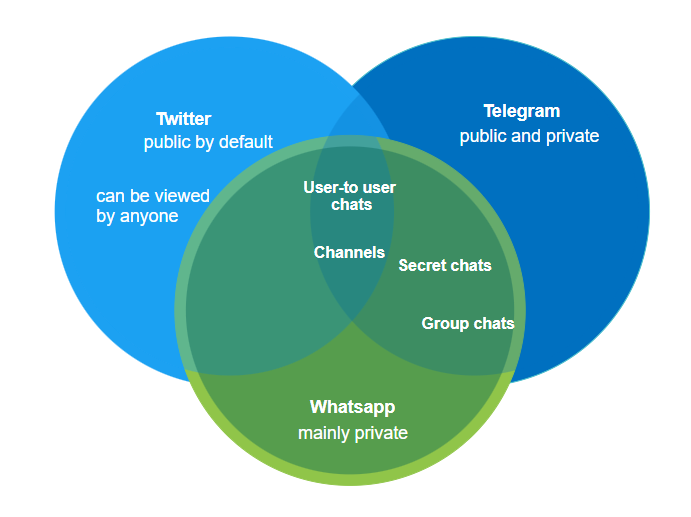
Telegram’s easy-to-access public space has recently become a popular new discussion arena among those who feel censored by the stricter moderation policies of mainstream social media platforms such as Twitter and Facebook Telegram is the largest, cloud-based, hybrid instant messaging (IM) application that can be accessed via smartphones, tablets, or desktop. It has several privacy-enhancing features that are arguably attractive to those who seek a platform that offers opportunities for publicity and mobilization whilst also safeguarding their anonymity in order to avert possible legal repercussions [1]. In our view, this makes Telegram a dark platform Telegram is the largest, cloud-based, hybrid instant messaging (IM) application that can be accessed via smartphones, tablets, or desktop. It has several privacy-enhancing features that are arguably attractive to those who seek a platform that offers opportunities for publicity and mobilization whilst also safeguarding their anonymity in order to avert possible legal repercussions [3]: one which welcomes the ‘deplatformed’ with open arms though policies of content liberation. The darkness of a platform, however, can be viewed in both positive and negative lights. Telegram has been the subject of media and scholarly attention as much for its ability to liberate marginalized communities as it has been for its potential to radicalize users who are exposed to extremist content.
Yet, we know little about the role of the increasingly popular but more secluded online spaces such as Telegram in fostering the formation of like-minded communities despite an increasing shift toward using IM apps (e.g., WhatsApp, WeChat, and Telegram), rather than large SNSs (e.g., Facebook and Twitter) for news consumption and discussion [4].
Given Telegram’s growing popularity amongst (deplatformed) digital exiles, and high potential for news dissemination, information consumption, mobilization, and radicalization, we set out to study information flows – with an emphasis on politically and socially relevant topics – within the Telegramsphere using the Netherlands as a case study.
Similar explorations of several Telegram chats were conducted by the Utrecht Data School, which were previously covered by Dutch media.
We analyzed the full messaging history (18/03/2017 — 18/06/2021) of 174 Dutch language chats (n = 80) and channels (n = 94) via a list of public Telegram chat and channel URLs that we fed into the Telethon Python library, which interacts with Telegram’s API. The channels and chats were identified via a list of access words (using the Telegram desktop app) that were related to current affairs (e.g., news, politics, names of political parties and their leaders). Given that at the time we conducted the study the Coronavirus pandemic represented a prominent issue of both the media agenda and the public agenda alike, we also included search terms that were directly related to COVID-19 and activism against COVID-19 safety measures (e.g., freedom, awakening, protest, etc.).
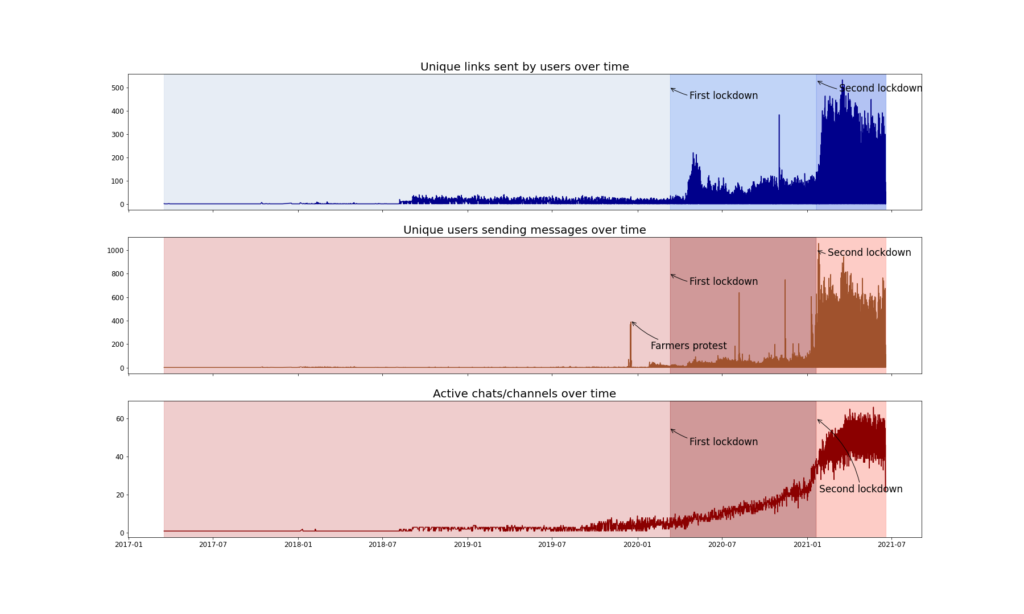
We analyzed a total of 2,033,661 text messages. These were sent by 55,331 unique users. Within these messages, users shared a total of 217,428 unique URLs; these belonged to 11,463 unique domains (i.e. websites). A large proportion of these links (28%) point to well-known social media platforms. These include Youtube, comprising a remarkable 18% of shared links overall (35,232 videos); Twitter with 6% (13,580 tweets), Telegram (3%) and Facebook (1%).
We found a total of 33,780 emojis in users’ text messages. The most frequently used emoji was
’👍’ (thumbs up – 7,070 times) followed by ‘😂’ (face with tears of joy – 3,344 times), and ‘🖤’ (black heart emoji 2,519 times).
We found a large diversity of unique website references within text messages, which suggests that Dutch Telegram users consume information that comes from outside of Telegram. The highest proportion of the identified links pointed to content from well-known SNSs such as YouTube or Twitter, which may indicate that Dutch Telegram chats and channels are well connected to other social media platforms. In fact, given the low proportion of Telegram links shared within messages, we speculate that the Dutch Telegramsphere has stronger cross-platform linkages with mainstream SNSs than interplatform ones between Telegram chats and channels. Following this train of thought, we suspect that those who use Telegram are not stuck in Telegram bubbles (at least not with regard to the sources they referred to within text messages). Future research must also consider the way users refer to these external sources, given that those who refer to content from mainstream media may simply do so to express their disagreement with it. For example, one could share an external source to debunk its validity.
Emojis appeared to play an important role in how Dutch Telegram users expressed themselves. Looking at the most common emojis used within text messages it is unsurprising that the most popular ones were ’👍’ and ‘😂’ given that these emojis are also prevalent on other messaging platforms. The frequent use of the ‘🖤’ represents a more puzzling finding. According to Emojipedia, it symbolizes sorrow, grief, dark humor, or morbidity. We speculate that the prevalence of the black heart emoji within the Dutch Telegramsphere could symbolize a reaction to the COVID-19 pandemic and the strict lockdown measures introduced by the government to combat the crisis. However more thorough analysis is needed to uncover the exact meaning of this symbol within the analyzed chats and channels.
@article{rogers_deplatforming_2020,
title = {Deplatforming: {Following} extreme {Internet} celebrities to {Telegram} and alternative social media},
volume = {35},
issn = {0267-3231},
shorttitle = {Deplatforming},
url = {https://doi.org/10.1177/0267323120922066},
doi = {10.1177/0267323120922066},
abstract = {Extreme, anti-establishment actors are being characterized increasingly as ‘dangerous individuals’ by the social media platforms that once aided in making them into ‘Internet celebrities’. These individuals (and sometimes groups) are being ‘deplatformed’ by the leading social media companies such as Facebook, Instagram, Twitter and YouTube for such offences as ‘organised hate’. Deplatforming has prompted debate about ‘liberal big tech’ silencing free speech and taking on the role of editors, but also about the questions of whether it is effective and for whom. The research reported here follows certain of these Internet celebrities to Telegram as well as to a larger alternative social media ecology. It enquires empirically into some of the arguments made concerning whether deplatforming ‘works’ and how the deplatformed use Telegram. It discusses the effects of deplatforming for extreme Internet celebrities, alternative and mainstream social media platforms and the Internet at large. It also touches upon how social media companies’ deplatforming is affecting critical social media research, both into the substance of extreme speech as well as its audiences on mainstream as well as alternative platforms.},
language = {English},
number = {3},
urldate = {2021-03-26},
journal = {European Journal of Communication},
author = {Rogers, Richard},
month = jun,
year = {2020},
keywords = {Deplatforming, Digital Methods, Extreme Speech, Social Media, Telegram},
pages = {213--229},
annote = {Publisher: SAGE Publications Ltd},
}@article{urman_what_2020,
title = {What they do in the shadows: examining the far-right networks on {Telegram}},
shorttitle = {What they do in the shadows},
journal = {Information, communication \& society},
author = {Urman, Aleksandra and Katz, Stefan},
year = {2020},
pages = {1--20},
annote = {Publisher: Taylor \& Francis},
}@article{zeng_conceptualizing_2021,
title = {Conceptualizing “{Dark} {Platforms}”. {Covid}-19-{Related} {Conspiracy} {Theories} on 8kun and {Gab}},
volume = {0},
issn = {2167-0811},
url = {https://doi.org/10.1080/21670811.2021.1938165},
doi = {10.1080/21670811.2021.1938165},
abstract = {This study investigates how COVID-19-related content, especially conspiracy theories, is communicated on “dark platforms” — digital platforms that are less regulated and moderated, hence can be used for hosting content and content creators that may not be tolerated by their more mainstream counterparts. The objective of this study is two-fold: First, it introduces the concept of dark platforms, which differ from their mainstream counterparts in terms of content governance, user-base and technological infrastructure. Second, using 8kun and Gab as examples, this study investigates how the ongoing COVID-19 pandemic has been communicated on dark platforms, with a focus on conspiracy theories. Over 60,000 COVID-19-related posts were studied to identify the most prominent conspiracy theories, their themes, and the actors who promoted them, as well as the broader information ecosystem through network analysis. While pressure on social media to deplatform conspiracy theorists continues to grow, we argue that more research needs to be done to critically investigate the impacts of further marginalizing such groups. To this end, the concept of dark platform as can serve as a heuristic device for researching a wider range of fringe platforms.},
number = {0},
urldate = {2021-06-18},
journal = {Digital Journalism},
author = {Zeng, Jing and Schäfer, Mike S.},
month = jun,
year = {2021},
keywords = {8chan, 8kun, conspiracy theory, COVID-19, dark participation, Gab},
pages = {1--23},
annote = {Publisher: Routledge \_eprint: https://doi.org/10.1080/21670811.2021.1938165},
}@techreport{newman_reuters_2019,
title = {Reuters {Institute} {Digital} {News} {Report} 2019},
language = {English},
author = {Newman, Nic},
year = {2019},
pages = {156},
}